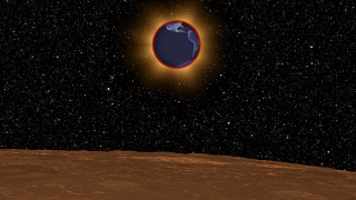Do You Want to See Earth from Distant Space?
Color and black-and-white images of Earth taken by two NASA interplanetary spacecraft July 19 show our planet and its moon as bright beacons from millions of miles away in space.
NASA’s Cassini spacecraft captured the color images of Earth and the moon from its perch in the Saturn system nearly 900 million miles (1.5 billion kilometers) away.
MESSENGER, the first probe to orbit Mercury, took a black-and-white image from a distance of 61 million miles (98 million kilometers) as part of a campaign to search for natural satellites of the planet.
[ Also Read: NASA to Host Google+ Hangout on Hurricane Research Flights ]In the Cassini images Earth and the moon appear as mere dots — Earth a pale blue and the moon a stark white, visible between Saturn’s rings. It was the first time Cassini’s highest-resolution camera captured Earth and its moon as two distinct objects.
It also marked the first time people on Earth had advance notice their planet’s portrait was being taken from interplanetary distances.
NASA invited the public to celebrate by finding Saturn in their part of the sky, waving at the ringed planet and sharing pictures over the Internet. More than 20,000 people around the world participated.
[ Also Read: Actor Jaden Smith Stars in a New NASA PSA ]“We can’t see individual continents or people in this portrait of Earth, but this pale blue dot is a succinct summary of who we were on July 19,” said Linda Spilker, Cassini project scientist, at NASA’s Jet Propulsion Laboratory (JPL) in Pasadena, Calif.
“Cassini’s picture reminds us how tiny our home planet is in the vastness of space, and also testifies to the ingenuity of the citizens of this tiny planet to send a robotic spacecraft so far away from home to study Saturn and take a look-back photo of Earth.”
Pictures of Earth from the outer solar system are rare because from that distance, Earth appears very close to our sun. A camera’s sensitive detectors can be damaged by looking directly at the sun, just as a human being can damage his or her retina by doing the same.
Cassini was able to take this image because the sun had temporarily moved behind Saturn from the spacecraft’s point of view and most of the light was blocked, said NASA.
Photo courtesy: NASA/JPL-Caltech/Space Science Institute





